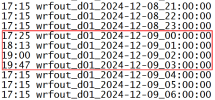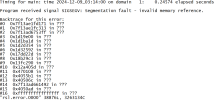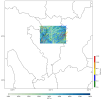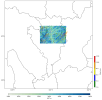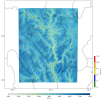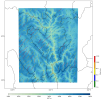Hello, I hope you're doing well. I'm currently running WRF-LES. After processing with ndown.exe, I'm operating the single-domain wef-les with a resolution of 0.333km. The simulation ran successfully for a period, but it aborted without any abnormal error messages after generating 3-hour worth of output files. When I checked the rsl log, the only message present is "Segmentation fault - invalid memory reference." There are no abnormal error reports such as CFL errors, so I'm unable to determine the cause of the abortion. If you have any helpful suggestions, I would greatly appreciate it. Below are my namelist.input file and the rsl log.
You are using an out of date browser. It may not display this or other websites correctly.
You should upgrade or use an alternative browser.
You should upgrade or use an alternative browser.
WRF stopped running with no abnormal error message
- Thread starter peng
- Start date
Hello, I've checked all the rsl.error* and rsl.out* files, and their contents are identical to the two files I provided. I tried searching for "cfl" and "NaN" using the command "grep -r 'xxx' ./rsl*", but no results were found. The only anomaly is the message "Segmentation fault - invalid memory reference." However, I don't think this is the actual issue, and I'm completely stuck on figuring out what's wrong. Any guidance you could offer would be truly appreciated.
It seems that you are running a real-data WRF-LES simulation (i.e., not an ideal LES run). Please let me know if I am wrong.
Segmentation fault often indicates physically wrong values like NaN occurrence in your simulation. Can you look at your wrfout file right before the model crash and see whether you can find some weird/unreasonable values?
Segmentation fault often indicates physically wrong values like NaN occurrence in your simulation. Can you look at your wrfout file right before the model crash and see whether you can find some weird/unreasonable values?
Hello, I really appreciate your reply. Yes, I am running a real-data WRF-LES simulation, and my domain scales are 9:3:1:0.333. I have checked the U10 and V10 values of the first two LES files (12-9-3 and 12-9-2) before the simulation stopped (as shown in the LES figure) and compared them with the wind data from the original WRF 3rd domain (1 km resolution) (shown in the WRF figure). I also examined the wind speed in the LES-12-9-3 file for any abnormal values. Unfortunately, I couldn't find any obvious clues. The terrain of my simulation area is quite complex, making the simulation challenging. I would greatly appreciate it if you could provide any suggestions.
Attachments
Besides, I have also tried before. In the same situation, the d03 starting time of wrf is 12-9-0. After using ndown, run les with the same starting time of 12-9-0. The simulation only generated a one hour simulation file, which terminated on 12-9-1:24. The situation is the same as this time. I think the departure time is too close, so I extended it. Although this simulation took longer, the same problem still occurred
Thank you very much for your suggestion. Currently, the model has generated files for 5 hours and is still running. I truly appreciate your help in resolving my issue.
I also have a question regarding running LES. I found that the guide suggests setting km_opt=2/3 and diff_opt=2 for running LES. Based on your advice, I set km_opt=5 and diff_opt=2. I would like to know if this setting will still work for running LES. I look forward to your answer.
I also have a question regarding running LES. I found that the guide suggests setting km_opt=2/3 and diff_opt=2 for running LES. Based on your advice, I set km_opt=5 and diff_opt=2. I would like to know if this setting will still work for running LES. I look forward to your answer.

